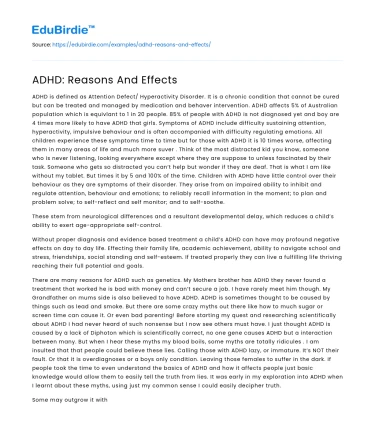Introduction
Attention Deficit Hyperactivity Disorder (ADHD) is a neurodevelopmental disorder that affects millions of children and adults worldwide. Characterized by symptoms of inattention, hyperactivity, and impulsivity, ADHD can significantly impair an individual's ability to function in academic, occupational, and social settings. The prevalence of ADHD has increased over the years, prompting extensive research into its causes and effects. While genetic factors are often highlighted, environmental influences and neurological considerations also play pivotal roles in the manifestation of ADHD. This essay seeks to explore the multifaceted reasons behind ADHD and its profound effects on individuals and society. By examining both the biological and environmental contributors, as well as the disorder's implications, we aim to gain a comprehensive understanding of ADHD, providing insights into potential interventions and support mechanisms.
Genetic and Neurological Factors
A significant body of research indicates that genetic factors are a major contributor to the development of ADHD. Family and twin studies have consistently shown that ADHD is highly heritable, with estimates suggesting that genetics account for approximately 70-80% of the risk for developing the disorder (Faraone et al., 2005). Specific genes, such as those related to dopamine regulation, have been implicated in ADHD, underscoring the genetic predisposition to the disorder. Furthermore, advancements in neuroimaging techniques have revealed structural and functional differences in the brains of individuals with ADHD. For instance, the prefrontal cortex, which is responsible for executive functions such as attention and impulse control, is often underdeveloped in those with ADHD (Arnsten, 2009). These neurological abnormalities provide a biological basis for the symptoms observed in ADHD.
Save your time!
We can take care of your essay
- Proper editing and formatting
- Free revision, title page, and bibliography
- Flexible prices and money-back guarantee
However, it is crucial to acknowledge that genetic predisposition does not guarantee the development of ADHD. Environmental factors can exacerbate or mitigate the expression of genetic vulnerabilities. This interaction between genes and the environment highlights the complexity of ADHD's etiology. Critics argue that an overemphasis on genetics may lead to a deterministic view, neglecting the potential for behavioral interventions and environmental modifications to alleviate symptoms. Thus, while genetics play a significant role, it is the interplay with environmental factors that ultimately shapes the manifestation of ADHD.
Environmental Influences
Environmental factors, both prenatal and postnatal, significantly influence the development and severity of ADHD symptoms. Prenatal exposure to toxins such as tobacco smoke and alcohol has been linked to an increased risk of ADHD (Thapar et al., 2013). Moreover, maternal stress and inadequate prenatal care can have lasting effects on a child's neurodevelopment, potentially contributing to ADHD. In early childhood, exposure to lead and other environmental pollutants has also been associated with ADHD, highlighting the impact of external conditions on neurodevelopment.
Postnatal environmental factors, such as family dynamics and educational settings, further contribute to the disorder's presentation. Children in families with high levels of conflict or inconsistent parenting are more likely to exhibit ADHD symptoms (Biederman et al., 2001). Similarly, educational environments that lack structure and fail to accommodate diverse learning needs can exacerbate attention deficits and hyperactivity. These findings suggest that modifying environmental conditions can play a pivotal role in managing ADHD. Critics might argue that focusing on environmental factors detracts from the biological underpinnings of the disorder; however, it is this comprehensive approach that offers the most promise for effective intervention strategies.
Societal and Individual Effects
The effects of ADHD extend beyond the individual, impacting families, educational systems, and society at large. Individuals with ADHD often face academic challenges, with studies showing lower rates of high school graduation and post-secondary education attainment compared to their peers (Barkley et al., 2006). These educational setbacks can lead to lower occupational achievement and increased risk of unemployment, contributing to economic burdens both for individuals and society. Moreover, the impulsivity associated with ADHD can lead to risky behaviors, such as substance abuse and driving accidents, further complicating the individual's social and economic standing.
On a familial level, ADHD can strain relationships, as parents and siblings must navigate the challenges of managing the disorder. The stress and frustration associated with ADHD can lead to increased familial conflict and decreased quality of life. From a societal perspective, the disorder contributes to substantial healthcare costs, with estimates indicating that the annual cost of ADHD in the United States alone exceeds $40 billion (Doshi et al., 2012). These figures underscore the necessity for effective management strategies and support systems to mitigate the disorder's widespread impact.
Conclusion
In conclusion, ADHD is a complex disorder with both genetic and environmental roots. Understanding the interplay between these factors is crucial for developing effective treatment and intervention strategies. While genetic predispositions highlight the biological underpinnings of ADHD, environmental interventions offer practical solutions for symptom management. The disorder's far-reaching effects on individuals, families, and society necessitate a multifaceted approach that includes medical, educational, and psychological interventions. As research continues to evolve, a comprehensive understanding of ADHD will pave the way for improved outcomes and enhanced quality of life for those affected. By addressing both the reasons and effects of ADHD, we can foster a more inclusive and supportive environment for individuals navigating the challenges of this disorder.






 Stuck on your essay?
Stuck on your essay?

